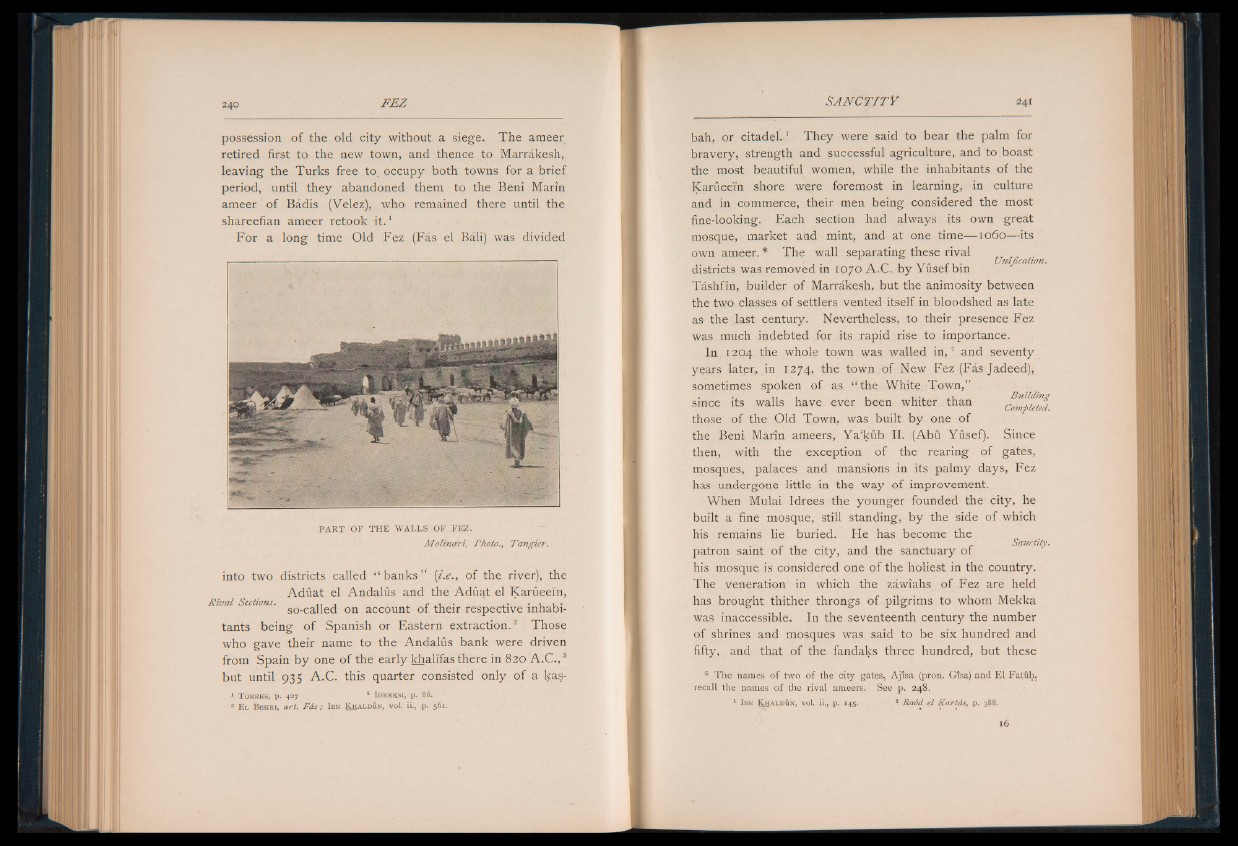
possession of the old city without a siege. The ameer
retired first to the new town, and thence to Marrakesh,
leaving the Turks free to, occupy both towns for a brief
period, until they abandoned them to the Beni Marin
ameer o f Bâdis (Velez), who remained there until the
shareefian ameer retook i t .1
For a long time Old Fez (Fâs el Bâli) was divided
P A R T OF TH E W A LLS OF FEZ.
Molinari, Photo., Tangier.
into two districts called “ banks” (i.e., of the river), the
Aduat el Andalus and the Aduat el Karueein,
Rival Sections. ,, , r ., . .. . , , . so-called on account of their respective inhabitants
being o f Spanish or Eastern extraction.2 Those
who gave their name to the Andalus bank were driven
from Spain by one o f the early khalifas there in 820 A .C .,3
but until 935 A.C. this quarter consisted only of a kas-
1 T o r r e s , p . 4 2 7 2 I d r e i j s i , p . 86.
3 E l B e k r i , art. F&s ; I b n K h a l d u n , v o l . i i . , p . 5 6 1 .
bah, or citadel. ,1 They were said to bear the palm for
bravery, strength, and successful agriculture, and to boast
the most beautiful women, while the inhabitants of the
Karuee'fn shore were foremost in learning, in culture
and in commerce, their men being considered the most
fine-looking. Each section had always its own great
mosque, market and mint, and at one time— 1060— its
own ameer. * The wall separating these rival
Unification.
districts was removed in 1970 A.C. by Yusef bin
Tashfin, builder of Marrakesh, but the animosity between
the two classes of settlers vented itself in bloodshed as late
as the last century. Nevertheless, to their presence Fez
was much indebted for its rapid rise to importance.
In 1204 the whole town was walled in ,2 and seventy
years later, in 1274, the town of New Fez (Fas Jadeed),
sometimes spoken of as “ the White Town,”
since its walls have -ever been whiter than Comphued
those of the Old Town, was built by one of
the Beni Marin ameers, Ya'kub II. (Abu Yusef). Since
then, with the exception of the rearing of gates,
mosques, palaces and mansions in its palmy days, Fez
has undergone little in the way of improvement.
When Mulai Idrees the younger founded the city, he
built a fine mosque, still standing, by the side of which
his remains lie buried. He has become the
. Sanctity.
patron saint of the city, and the sanctuary of
his mosque is considered one of the holiest in the country.
The veneration in which the zawiahs of Fez are held
has brought thither throngs of pilgrims to whom Mekka
was inaccessible. In the seventeenth century the number
of shrines and mosques was said to be six hundred and
fifty, and that of the fandaks three hundred, but these
* The names of two of the city gates, Ajisa (pron. Gisa) and El Fatuh,
recall the names of the rival ameers. See p. 248.
1 I b n K h a ld u n ., v o l . i i . , p . 1 4 5 . 2 Raod el Kartds, p . 388.